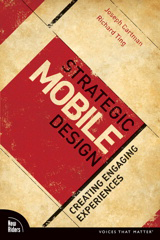
Strategic Mobile Design – Creating Engaging Experiences
by Joseph Cartman and Richard Ting
http://www.peachpit.com
222 pages
ISBN: 978-0-321-58007-8
US $34.99, CAN $37.99, UK £22.99
The mobile devices industry is in turmoil–a statement that could be ripped from the headlines of any newspaper, magazine, or website. Not only is the economy in rough shape (something to which I can personally attest), but the traditional cellphone of yore is also undergoing radical changes.
It probably started with the first Palm Treo phones, which introduced the category of smart phone to the public, grew with the Windows Mobile and Blackberry platforms, and ultimately validated with the very successful Apple iPhone.
Many of you with mobile devices have likely suffered through the first and second generation WAP browsers with glacial speed (pre-3G) on phones with tiny screens, and almost wish you could plunge an ice-pick into your skull rather than have to suffer through another WAP browser session. I certainly felt that way, and I worked in the mobile devices industry! Engineers and marketing folks whom I worked with just couldn’t believe that I was being so negative about WAP. Guess I didn’t drink the Kook-Aid.
Enter 3G networks and smartphones. Larger screens, faster processors, and faster networks made it possible to greatly enhance the user experience, and therefore bring more profits to the carriers.
With bigger screens and improved bandwidth came new opportunities for website designers and information developers, and this is where this book comes in.
The authors refer to the shift in mediums from print to electronic (radio/TV), and the web, finally ending with mobile media–content designed expressly for the new mobile devices. They also delve into some of the challenges faced by designers for this new medium–screen sizes, while bigger, are not consistent, so adjustments need to be made to accommodate more than one size screen.
Creative strategy is a three-pronged approach to mobile media: concept, creative, and technology.
- Concept relates to audience research and how mobile media might offer a solution to a perceived or real problem.
- Creative relates to user interface design and how to translate this design to screen sizes varying from 176 x 128 pixels, up to 320 x 240 and even larger.
- Technology relates to how these solutions are delivered to the user: SMS (Simple Message Service) or MMS (Multimedia Message Service), mobile web sites (web sites optimized for mobile devices), downloadable applications, rich technologies (such as Flash), and IVR (Interactive Voice Response).
The authors remind designers about global issues, and how some companies work with these issues. They also do a broad analysis of the Americas, Asia-Pacific, and EMEA (Europe, Middle East, Africa), discussing protocols used and unique issues, cultural and otherwise, within the regions, and help designers with appropriate strategies. For example, mobile users in Japan make extensive use of QR barcodes which users can “scan” with the cameras in their phones. Ultimately, pertinent information related to that barcode is provided to the user without having to type long URLs into their phones, which, if the user doesn’t have a QWERTY keyboard, can be a time-consuming and annoying process.
There are so many interesting mobile applications out there that are just now becoming available, such as:
- Micropayment: Use a mobile device to pay for small purchases on the fly.
- Interactive television.
- Controlling digital billboards.
- Google SMS
- Amazon TextBuyIt
- NY Times Real Estate
I never really understood the different modes of communication and how users can benefit from them.
- Mobile to Mobile: Specialized mobile banner ads, cross-linking, SMS, live feeds.
- Web to Mobile: Web to SMS (interact with websites via SMS), download and sync (downloaded apps with a live feed component), interactive voice response (IVR).
- Out of Home (OOH) or Print to Mobile: SMS (get more information on goods and services via SMS) and subscribe to services, Bluetooth and WiFi, 2D Barcodes (QR and Scancode), Mobile Internet to Print, Broadcast to Mobile, Mobile Internet, Radio to Mobile, Podcasts and Audio Streaming, Multichannel.
Next, the authors discuss designing for the intended audience and their handsets and all the technical and design hurdles that need to be overcome.
Interaction design goes into the process of designing for the small screen, including an excellent section on the mobile interaction design process, and why mobile design projects really need process definitions to ensure program success.
Visual design is the fun part; determining what the user is going to see when they access your application or website. It delves into color selection and optimization, as no two mobile devices reproduce colors in the same way. Then there’s typography: can you read the content on the screen without eyestrain? Are you using standardized icons for commonly used symbols? Using page layout to define and standardize what the user sees and how they get from screen to screen. It also goes into the issues of integrating various types of media (video, audio, etc.), as well as file-type standards for efficient transmission over the mobile network.
Then the authors discuss some of the popular and cutting-edge tools used for developing mobile solutions.
The rest of the book details a number of interesting applications for mobile media technology in areas such as location-based shopping, the use of barcodes and RFID technologies, urban navigation with a touch of the social, use in academia, and use in art.
The authors cram a ton of thought-provoking information into this book’s 222 pages. It’s not so much a cookbook as a launching point for developers of applications and technologies being used (or planned for use) in mobile devices–to give them some ideas of what’s been done, and what can be done (the lack of Flash technologies in Apple iPhones notwithstanding). If you are in one of those categories, this is a must-have volume.
MyMac.com rating 4.5 out of 5.
email – MyMac Magazine – Twitter – Advertise – Reviews Archive – Podcast

Leave a Reply
You must be logged in to post a comment.